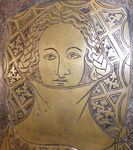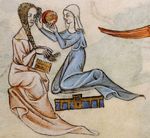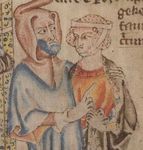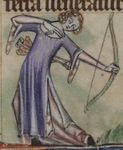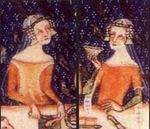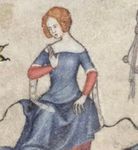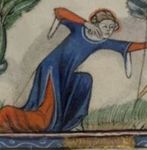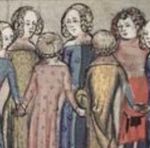Fourteenth Century Hairstyles By Lady Rosalie Langmod - For the Weekend Reenactor
←
→
Page content transcription
If your browser does not render page correctly, please read the page content below
Fourteenth Century Hairstyles
For the Weekend Reenactor
By Lady Rosalie Langmod
MKA: Kali Jackson Armstrong
Clothier’s Seminar, February 2nd, 2019
email: r osalie.langmod@yahoo.com
myladymother.wordpress.comIn the decade that I’ve been a reenactor, both in nineteenth century
reenactment and medieval recreation, I’ve learned that it’s the little details
that make the difference in achieving a period ensemble. For me, the two most
important areas (which are sadly always the last points to be addressed) are
appropriate footwear and appropriate head dressing. In this class and handout,
I hope to enable you with tips and tricks in how to dress one’s hair in authentic
ways.
First of all, relax! It’s a lot easier than you think and you can achieve
these hairstyles using materials you probably already have in your house.
(Even if you’re doing it using completely period methods!) The biggest
obstacle is only the fact that, because some of these hairstyles are so foreign to
contemporary sensibilities, it is difficult to get sufficient practice. It’s my hope
that the advice I offer will help you over the hurdles.
HISTORICAL OVERVIEW:
While I would certainly never want to be without shampoo and
conditioner, there are some medieval hair remedies which actually make sense
and even work quite well. For example, aloe vera is probably won’t combat hair
loss as prescribed in the Tacuinum Santiatis, but it makes a wonderful
conditioner and detangler. In fact, I use aloe vera gel mundanely and it has
made my son’s hair more luminous and it triples as a hair gel! (It’s great for
curly hair.) Other medieval recommendations, like rinsing with vinegar or
goats milk, or conditioning with olive oil, are still listed as “natural hair care”
prescriptions on pinterest! Meanwhile, henna and indigo have both come back
in vogue as natural dyes, much like our medieval counterparts.
For quick reference of medieval applications:
Cleaning: Vinegar (I once read that apple cider vinegar was good for brown
hair), goatsmilk, lye.Conditioning: Olive oil, Aloe Vera, Animal Fats. (Apply olive oil as a hair mask
prior to a shower and wash thoroughly. Be careful as it can make your shower
floor very slippery. Aloe Vera can be applied by the gob-fulls before, during,
and after your shower. --I would never use animal fats in my hair for obvious
hygienic reasons.)
Dyeing: Sun-bleaching (everyone was trying to be blonde), henna, and indigo.
(While young girls tried to lighten their hair, older women tried to disguise
gray hair by darkening it with indigo.)
Hair Tools: Boar’s Hair Brush, tight combs (heavily decorated), a hair pick
(also decorated), hair pins, ribbon, and thread.
MODERN HAIR VS MEDIEVAL HAIR
While most medieval hairstyles aren’t very difficult to achieve solely
using period tricks, provided your hair is long enough, the 14th century ladies’
disadvantages in regards to hygiene were actually a leg up when it came to
styling. Modern shampoo strips hair of sebum which, while kind of yucky,
helps hair to hold it’s style. Consequently, the reenactor not interested in
recreating the odors of the past, should feel free to use pomades and hair gels
to compensate for the lack of sebum.
For my own part, I prefer using hair pins made by the Twisted Calontiri
(Nikita Pashavich) both for reenacting and mundane use as they hold better
and with greater comfort than any other product I’ve used. They’re styled after
medieval pins, but made with copper as opposed to wood. That said, while
medieval techniques, in my opinion, result in a more comfortable and
surprisingly durable hairstyle, the one modern convenience which I would
rather not do without are hair-ties and elastics.
HAIR STYLES:
In most Christian cultures in the Middle Ages, an adult woman
(especially a married one) would not be seen with loose hair in public unless
she was a queen at her coronation. (British Coronation portraits usually try to
emulate the Virgin Mary in the representation of the queen.) Loose hair is
primarily reserved for virgins and in many of the sources I’ve reviewed in
preparing for this class, it’s clear that there is also a sexual connotation toflowing hair that was to be avoided by a good woman. In fact, it’s desirable for,
the most part, for women to cover their hair altogether, but it’s clear from
manuscripts and statuaries that this clerical admonition was often bent and
even broken.
In truth, most hairstyles during the pre-modern era aren’t terribly
difficult to execute, and many are much more accessible to contemporary
stylists. Prior to the 1200s, the most common hairstyle was either one or two
simple plaits. During the 13th century, crespines and Birgitta caps became
popular and would have encased either two low buns or pinned braid coils.
Later medieval hairstyles (except for the big Elizabethan poofy styles) are not
often as foreign to us in contrast to the popular styles in England and France
during the 1300s. Those of us with long hair generally braid it or style it in
criss-cross crown braids just to run errands. However, few of us would style
our hair in Princess Leia buns, horizontal, or vertical plaits to go to work or the
grab lunch with friends and these are the hairstyles that are a little tricky to
execute without practice.
Another reason I think that we tend to leave off attempts at period
hairstyles is that many of us live under a myth that our medieval counterparts
had hair that flowed for metric yards. Given their use of false hair and the
problems for which herbal remedies are prescribed, we can be safely assured
that they had the same difficulties with growing their hair out as we do.
Moreover, experience has taught me that, with a few exceptions, 14th century
hairstyles can actually be easier to execute with moderate (at least be SCA
standards) hair lengths --about shoulder blade length.
The final reason I think some of us decline to use Medieval Hairstyles is
that they simply don’t fit into our modern ideas of what’s attractive. I can’t tell
you how many times my mother has made fun of my hairstyle when I’m
headed out to an event, but when I look in the mirror, I realize that the braids
swooping parallel to my cheeks frame my face beautifully and bring out the
color of my eyes. Princess Leia buns make me feel like Sophie Marceau in
Braveheart. Embrace the fact that you yourself are beautiful and you’ll find your
beauty and confidence within the period aesthetic.
Hairstyles By Region:Germany: Loose and flowing if you’re unmarried, usually with a
barbette and fillet. Single plait down the back, also with a barbette and fillet.
Finally, knotted at the nape of the neck and hidden beneath a veil.
ITALY: T
he same as Germany except with less headwear. Italian ladies
also wore their hair criss-crossed in a crown over the top of their heads. They
were also unlikely to hide their hair beneath veils.
France/England: Despite the intense rivalry between these countries,
their fashions were often very similar and the same can be said of hair. While
peasant women would hide their hair beneath veils, noble women and queens
are depicted hunting and being regal with side buns (either Princess Leia style
or set beneath the ear lobes), vertical plaits (either set at the temples or
wrapped upwards from the nape of the neck), horizontal plaits (which can be
executed in a number of ways), or a combination of horizontal and vertical
plaits.)
Hairstyles by Length:
While one can certainly adapt hairstyles to work with hair length, the
following hairstyles are better suited to the prescribed hair lengths (in my
opinion).
Long/Thick Hair,: Princess Leia and Low Sidebuns, Combination
vertical/horizontal plaits.
Moderate/Thin Hair: Vertical Plaits (both types), Horizontal plaits (both
types, depending on length), and low buns.
Note: Side buns should always be covered with a crespine.
While f rench and dutch braids are not documentable p
rior to the nineteenth
century, dutch braids can be used to give the impression of having more braid
to work with and can act as a good anchor.
Crespines/hairnets should ALWAYS been worn over hair that’s been styled. In
the Middle Ages, they were used to protect hairstyles, not to hold up loose hair.
(This would have been difficult without elastic and the netting was not very tight,
especially compared to modern crocheted snoods.)HAIRSTYLE INSTRUCTIONS:
These are very basic instructions on how to execute some fourteenth
century hairstyles. Depending on the length (or shortness) of your hair, you
may need to make some accommodations. If you’re reading this handout
without attending my class, please feel free to reach out to me directly with
questions either in the email on the cover page or in person at an event and I’ll
try to help.
Side Buns: This hairstyle is easy to execute and very grand looking,
especially when dressed up with headwear. The downside is that the Princess Leia
style requires both thickness and length, and the weight can cause headaches for
the tender-scalped. (Or even the seasoned scalp.)
1.) Part hair directly down the center from the middle of the brow to the
nape of the neck.
2.) Gather hair into two pigtails; either parallel the top of the ears (for
Princess Leia style) or below the ear lobe and half between the ears and
the back of the head for low buns.
3.) Braid pigtails. (Optional, you can weave a ribbon through the plait.)
4.) Coil into buns and pin.
5.) Cover hair with a crespine.
Period techniques: Use ribbon or string in place of hair ties and elastics and sew bun
into coil to help pins hold up.
Vertical Plaits: There are a variety of ways to achieve this look, depending
on length etc. For all versions, the hair should be parted down the middle as with
Side Buns.
Version A: (When done using period techniques, this hairstyle can withstand
a rigorous day of housework. Perfect for an active day at an event! However, it looks
best with shorter hair: mine is so long that I looked like a Swedish milkmaid rather
than a medieval noblewoman.)
1.) Gather hair into plaits on either side of the forehead at the temples.
(Optionally, weave ribbon through the plaits.)
2.) Tuck the end of the braid into the “pocket” created by the hair at the
top of the braid and pin in place. (For longer hair, you can fold it into thirds so
that the fringe peaks out at the bottom.)3.) Sew or pin the plait closed so that the “hoop” is closed. (Sewing holds
best and doesn’t poke the wearer’s ears all day, unless you are clumsy with the
needle.)
4.) Remove pins or leave them as you please.
Version B: (This one is easier done with a barbette to cover the fringes at the
top.)
1.) Gather hair into two plaits at the nape of the neck. (Higher if your hair is
shorter. Again, one can easily weave ribbon through the plait.)
2.) Pin the ends of the braids at the top of your head so that the fringes are
hidden.
3.) The result should be two plaits that run from the top of the head along
the temples and cheeks before ducking up behind your ears.
Version C: (This is the last one I’ll describe, but this is certainly not the only
way you might execute this style. I find it’s harder to sew the plaits onto
unbraided hair, so it’s more reliant upon bobby pins which makes it’s less
durable or comfortable. It also takes more practice, but it’s really just a simple
trick at the end of the day.)
1.) Gather hair into pigtails near the back of your head, along the
crown.
2.) Braid hair into plaits.
3.) If necessary, pin your hair to hide hair-ties. (You can always cut
the hair ties once the style is complete.)
4.) Pin or sew plait along crown until it reaches your templet. (If your
hair is too long, simply criss-cross the plaits at the back and send
them along the opposite sides of your head.)
5.) Fold the remaining plait in half and pin the fringe underneath the
plait.
6.) Sew or pin the hoop shut.
Note: While it looks sloppy to the modern eye, fourteenth century women
incorporated the fringe into the hairstyle. They even trimmed it so it was all an
equal length.
Horizontal Plaits: This style is certainly the strangest to modern eyes, but
it’s perfect for moderate hair.
1.) Part and gather into pigtails as with Princess Leia Buns for long hair,
further back as with Version C for shorter hair. --Plait.2.) With long hair, fold plait back towards the center. With shorter hair,
only pin back to hide the hair tie.
3.) Pin towards the temple.
4.) Fold the fringe under the braid and pin into place.
For shorter hair, you can “fake” this hair style by dutch braiding from the back of
the head to the temple and then folding the fringe inside the “pocket” and pin.
For longer hair, you can wrap the two plaits criss-cross along the back.
If at first you don’t succeed, don’t worry! This style takes practice and was often
covered with a wimple in period.
SPECIAL CONSIDERATIONS:
So your hair simply won’t fit into these styles due to length or texture? No
worries! A veil and wimple isn’t your only option. Our medieval counterparts
used wool or human hair bought from someone with a genetic advantage but a
financial disadvantage. (The latter which was frowned upon by the clergy.) You
can braid false hair into your own plaits to add thickness or simply create false
plaits and sew them to fillets just like they did in period.
If, conversely, you have so much hair that achieving these styles is either a
terrible chore or brings on a horrid headache (or both), you can always use only
part of your hair for a vertical plait or side buns while braiding the rest into a
single plait down your back. Additionally, you can simply plait your hair down
the back (or knot it at the nape) and use false hair as prescribed above.
CONCLUSION:
While I commend anyone wishing to use medieval techniques, (and even
prefer some of them myself), I also urge you to have grace with yourself. Unlike
our medieval counterparts who styled their hair this way regularly, we only do
so on weekends and the odd week. They have on their side, you should not feel
guilty about adopting any of the cheats prescribed.
At the end of the day, medieval hairstyles are not as inaccessible as you
may think and they truly make all the difference in adding to the magic. The
grandest ensembles can fall flat when paired with a modern hairstyle, but a the
simplest cote can look like it came straight out of a manuscript when pair witha period hairstyle. I hope the advice I’ve shared will help you feel confident enough to give it a go!
Figure 1: Luttrell Psalter, a lady having her hair done by a very grumpy looking maid. (1327-1340) Figure 2: 14th Century Funerary Brass
Figure One: Luttrell Psalter: Side buns with exposed fringe. Figure Two: Holkham Bible: Side buns covered with a crespine. 1325-1350 AD.
Figure 1: Taymouth Hours; Side buns under crespine. 1325-1335 AD Figure 2: Horizontal Plaits. (Also Taymouth Hours)
Figure 1: Romance of Alexander: “Combo” Vertical and Horizontal plaits. 1340 AD Figure 2: Back view.
You can also read
